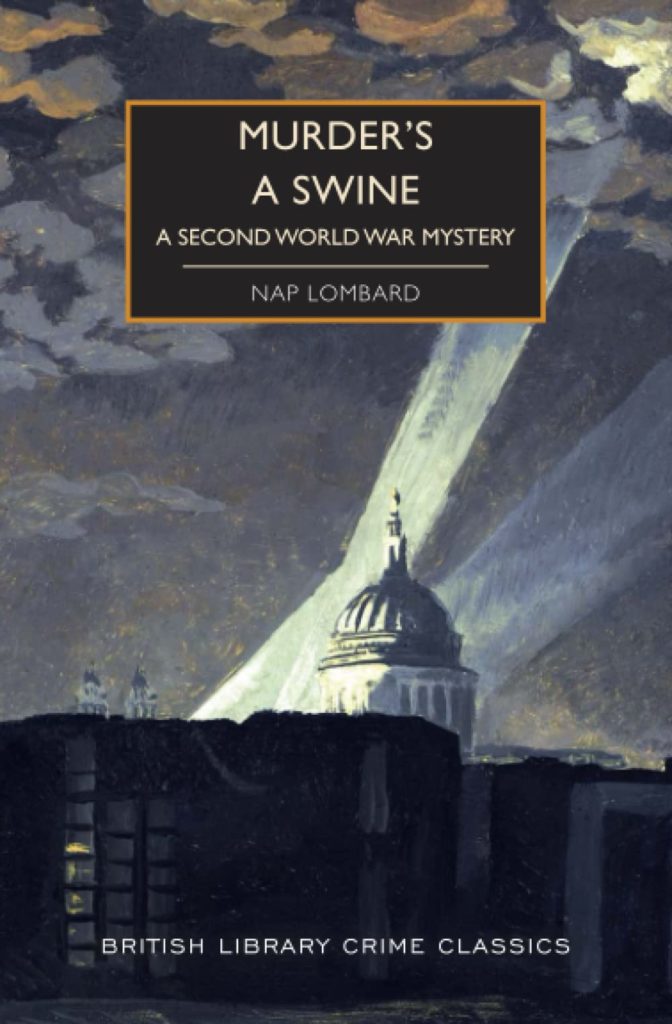 In autumn of 1940, London was subjected to 57 straight days and nights of aerial bombed by the German forces. In addition to the toll it took on official military efforts, relief and recovery relied on civilian volunteers. They divided their territory into apartment blocks and neighborhood squares. They organized makeshift air raid shelters and hauled buckets full of sand up to each floor’s hallway in case of fire. This is the setting for the contemporaneous mystery novel.
In autumn of 1940, London was subjected to 57 straight days and nights of aerial bombed by the German forces. In addition to the toll it took on official military efforts, relief and recovery relied on civilian volunteers. They divided their territory into apartment blocks and neighborhood squares. They organized makeshift air raid shelters and hauled buckets full of sand up to each floor’s hallway in case of fire. This is the setting for the contemporaneous mystery novel.
Author Nap Lombard was actually the pen name of married couple Pamela Hansford Johnson and Gordon Neil Stewart. The two wrote this novel (and one other) set in Blitz London while they were living it. In fact, they were air-raid wardens themselves — the simultaneous monotony and chaos of inspired their writing.
Though it occurred to Clem that she might herself have put the dead gentleman in the sandbags and that he should detain her on suspicion, it did not occur with sufficient force to promote action of any kind. Miserably he watched while Mrs. Kinghof darted on lovely legs through the wet, her mackintosh gleaming like starry water, and he had one awful, paralysing moment of imagining that the corpse was crawling up the stairs behind him to pass its cold and earthy hands about his throat. ~ Pg. 6
In Murder’s A Swine, Agnes Kinghof discovers a body in a raid shelter. Meanwhile, an upstairs neighbor is being weirdly threatened with the head of a pig. Agnes and her husband call their friend with Scotland Yard but insist upon running their own amateur investigation. A madcap adventure, with a couple more murders and humorous banter ensues.

Clearly influenced by the antics of Hammett’s Nick and Nora Charles, and Christie’s Tommy and Tuppence, this book tries to capture the same giddy sleuthing. It’s solid and engaging but it doesn’t quite have the sparkle and shine of those pairs.
Even so, it’s a fun adventure and a good mystery. And it’s a curious glimpse into a specific time in history, written by people living it, while it was still happening. Descriptions of everyday life, both untouched and impacted by war are injected throughout. Banality in the midst of disorder.
The furniture was cottagey — that is, liable to unstick at the joints — and the curtains, carpets, and cushions bore respectively the print of rhododendrons, roses, and apple blossom. Every drop of water had to be pumped from the river, and there was a rather unprepossessing water closet of the type that is usually at the end of the vegetable garden, and was in this case adjacent to the scullery. ~Pg. 78
Those who enjoy vintage murder mysteries will be glad to add this one to the library.
My thanks to Sourcebooks for the review copy.
My rating: [xyz-ihs snippet=”4-Stars”]
Publisher: British Library Publishing (February 10, 2021)
Language: English
ISBN-10: 071235378X
ISBN-13: 978-0712353786
